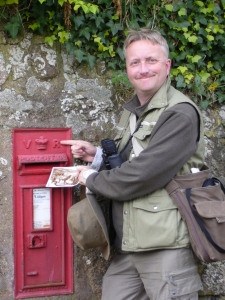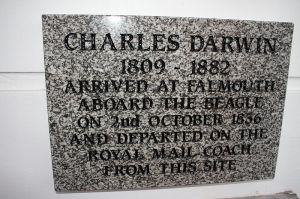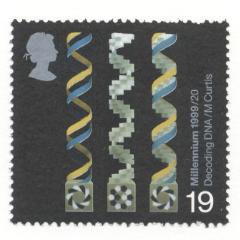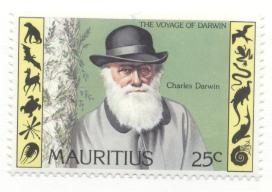
One of the best preserved working Victorian post boxes I have ever seen or used (despite being near the sea and many repaints) on St. Mary's, Isles of Scilly, 2006. Look for these in your area on your own Victorian stamp time safari! Imagine how many Victorian letters and postcards to Cousin Jacks overseas must have passed through this post box. How many bright holiday greetings, christmas cards, Valentine's and sad black bordered letters. Reading WH Auden's poem Night Mail gives a flavour of what life in letters must have passed through this and continues today (mostly happy holiday postcards like this Gibsons Of Scilly archive image postcard now!)
Charles Darwin as a well off Victorian family men would have made much of Christmas, which it is often and popularly said, was invented by Charles Dickens and the Victorians. For those of you who saw the evocative Christmas specials of BBC’s Victorian Farm set in the 1880s, the decade of Darwin’s death, there are 25 fabulous free craft resources for celebrating or preparing for next Christmas on the bbc.co.uk/victorianchristmas website.
From handmade crackers to parlour games, toy theatres to paper marbling, decorations to recipes, there are some fabulous decorative ideas for use in the classroom or stamp room. The first Victorian Christmas card by Horsley and Cole is shown (only ten survive, so they are worth tens of thousands!). The halfpenny post rate for Christmas cards meant that they were originally written only the front decorated picture side, like many Victorian zoo postcards in the Newquay Zoo Victorian life collection, as nothing but the address was at first allowed on the address side. There are some lovely template Victorian cards on the website for use in school, great for handwriting practice and creative writing tasks. However real Victorian Christmas cards (and the scraps they resemble) for showing in the classroom can easily and fairly cheaply be found in junk / antique shops and sites like Ebay.
The bbc.co.uk/victorianchristmas site is organised as an ‘advent’ calender of 25 downloadable windows of Christmas activities featuring instruction templates and short video clips to watch at home or school with the three fabulously enthusiastic presenters Alex, Ruth and Peter. Think of it as a Victorian farmhouse Blue Peter ‘make’ .
More ideas for your Victorian stamp and time safaris out
Hopefully you had a relaxing christmas with its Victorian traditions (or tack), watched Victorian Farm, Cranford and Doctor Who, so are now looking forward to fresh sir, a few walks to get rid of Christmas pudding pounds and some inspiring visits (through time) out in 2010. We hope you liked the teaching suggestions in the last blog about going out and around your neighbourhood as Victorian time detective. The BBC Victorian Farm original series is out on DVD (Acorn Media), set at Acton Scott Historic working farm in Darwin’s birth and childhood county of Shropshire. Shopping in Blists Hill Victorian village is shown on the series , whilst similar Victorian villages exist at Beamish, Black Country Living Museum, York Castle Museum, Flambards and Morwhelham Quay in Cornwall. Newquay Zoo is signed up to the Learning Outside the Classroom manifesto and quality badge scheme, so hope you will go out of the classroom or house on your Victorian time and stamp safari.
Darwin was also an accomplished botanist and interested in the work of many plant hunters sent out by his friend Hooker at Kew Gardens (sharing with Darwin an anniversary year and commemorative Royal Mint coin this year). We have in the office the superb Great Plant Hunt resource box sent out to all UK primary schools in 2009 – resources are downloadable at www.greatplanthunt.org).
Tracking down rarer stamps can be as hazardous, murderous or dangerous as the quest for rare orchids. We’ll be featuring some of the Darwin stamp book stamps of plants, dinosaurs and different countries in our activity trails at Newquay Zoo in 2009 and 2010, showing how flexible and useful they can be as inspiration and illustration. Plant hunters of the Victorian era will be celebrated through the characters of ‘Edwardiana Jones’ and his sister ‘Victoraina’ in our Plant Hunter trail events schedule at Newquay Zoo in May 2010 onwards. Acorn Media also publish the DVD of the Victorian Kitchen / Garden series from the 1990s, worth tracking down especially once you’ve seen the Victorian estate, garden and railway restorations such as at Trevarno in Cornwall with its toy museum and National Gardening Museum. Heligan and the great heritage gardens of Cornwall including the one that Fitzroy, Darwin’s Captain of the Beagle visited when the Beagle docked in Falmouth such as Penjerrick gardens (near Trebah Gardens) are restored to their Victorian glory and open. Some of these such as Glendurgan are run by the National Trust across the UK and your local regional versions of English Heritage should have many more inspiring Victorian sites (such as Lanhydrock in Cornwall) for you or your school to visit. Quuen Victoria’s Osborne House on the Isle of Wight and Down House, Darwin’s home in Kent are both English Heritage properties. The Victorian Society also do adult study tours, talks and Victorian pub crawls!
More ideas for your Victorian stamp and time safaris inside
Like The 1900s House and Adam Hart Davis’ What the Victorians Did For Us before it, the BBC Victorian Farm is an excellent programme and website for ideas. Lots of the craft activities could be adapted using stamps as decorative items, something the Victorians did themselves with countless early and now precious stamps! It took a few years after Rowland Hill’s Penny Post (the Penny Black issued on 6th May 1840) for the collecting or classifying brain of a ‘stamp world Darwin’ and the entrepreneurial luck of men like Stanley Gibbons (1840 -Penny Post year -to 1913) to establish stamp collecting as the worldwide hobby and trade it is today, rather than a craft pastime.
It was however not just a boy’s pastime, something Beryl Rennie the Scottish stamp collector ,whose legacy bequest made the Darwin stamp book possible, would be pleased to have known. I have met many female stamp collectors but not sadly one of the first recorded ones, a young Victorian girl who wrote to the Times newspaper in 1841, asking readers to send her postage stamps for her collection. She was quick off the mark , but limited in choice as only three stamps existed then to collect , the Penny Black, Twopenny Blue and Penny Red.
Maybe she was doing creative and imaginative craft work with them, as Sandie Robb the Darwin200stampzoo blog co-author continues to do at her fabulous wildlife stamp weekends at RZSS Edinburgh Zoo. Victorians such as Albert Schafer plastered the walls with them, covered tables, chairs, fire screens, wreaths, maps, tea services in willow pattern, guitars, pianos, mantlepieces, model ships, made self-portraits, even covering whole rooms with stamps! This craft tradition using stamps in a decorative way is still continued in Cornwall where Newquay Zoo is based, with many fine stamp craft objects by local artists and crafts people in galleries such as in St. Just.
Stamp collectors like our Victorian girl seem to be faster to react than organised business. The first stamp album was not produced until 1862 and guide to stamp prices until 1863.
Stamps (especially Christmas ones) are great I found this year for Christmas decorations and keepsakes, bringing us back to the 25 brilliant craft ideas on the BBC Victorian Farm website bbc.co.uk/victorian christmas. There are some great craft and decorative articles in the free online Victoriana webzine / magazine http://www.victoriana.com/ a US based Victorian website worth signing up to!
We’ll feature more about stamps for decorative craft as well as stamp collecting for teaching resources in future blogs, including your portrait in stamps inspired by Victorian examples made of stamps. There are many fine portrait stamps of Darwin to feature in our book and blog, portraits of many kinds being good materials for an interesting classroom activity. Newquay Zoo – and myself in tiny form- had our ‘portrait’ painted many times in 2009 (the zoo’s 40th birthday year) as part of the Darwin 200 celebrations by our resident Cornish artist John Dyer working with Falmouth Art Gallery (see the weblinks). If you look carefully on his online gallery in his Zooing Around print of the zoo at dawn, you’ll spot a tiny me leading a tour by torchlight! More next time.
Happy New Year! or as our Edinburgh Zoo colleagues say, Happy Hogmanay!
Some more Victorian schools resource links
More Darwin and Victorian links
The BBC’s Victorian Farm series is based at Acton Scott’s historic working farm in Shropshire, Darwin’s birth and childhood county
http://www.actonscott.com/
http://www.actonscott.com/shropshire.php based in Darwin’s birth county
http://www.bbc.co.uk/shropshire/darwin/
http://www.darwinshrewsbury.org/ with its 2010 Shrewsbury Darwin Festival 2010 12th – 14th February
http://www.shift-time.org.uk/blog/
Step back in time: Victorian towns and villages
Lots of downloadable activities, visit details and links at each of these sites
http://www.beamish.org.uk/
http://www.kirkgatevictorianstreet.org.uk/ York castle Museum’s virtual Victorian street tour
http://www.bclm.co.uk/ Black Country Living Museum, Dudley http://www.bclm.co.uk/witeachersresources.htm
http://www.ironbridge.org.uk/learning/resources/ Blists Hill Victorian Town
http://www.flambards.co.uk/exhibitions/the-victorian-village-experience.html Flambards
Learning outside the classroom manifesto website including advice on taking school trips out and about guidance and link to list of quality badge holders.
http://www.lotc.org.uk/
Victorian Gardens and properties to visit
Heligan – atmospheric photographs
http://www.heligan.com/ or http://www.heligan.com/non_flash/
Penjerrick
http://www.penjerrickgarden.co.uk/history.html
Trebah
http://www.trebahgarden.co.uk/history_of_trebah.htm
Glendurgan and Lanhydrock
http://www.nationaltrust.org.uk/
Osborne House
http://www.english-heritage.org.uk/server/show/nav.19473
Down House
http://www.english-heritage.org.uk/server/show/nav.19529
http://www.charlesdarwintrust.org/education
Stanley Gibbons
http://www.gibbonsstampmonthly.com/Journals/GSM/Gibbons_Stamp_Monthly/July_2006/attachments/sgstory.pdf
http://www.bbc.co.uk/history/british/victorians/
http://www.nationalarchives.gov.uk/education/victorianbritain/
http://www.victoriana.com/
http://www.victorianweb.org/index.html
http://www.history.ac.uk/ihr/Focus/Victorians/
http://www.bl.uk/onlinegallery/onlineex/earlyphotos/index.html

















